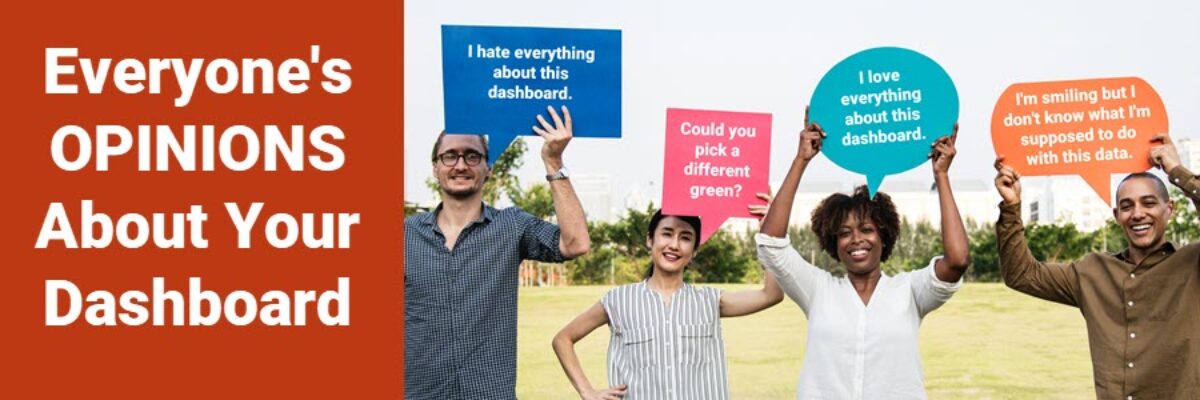The primary struggle with dashboard development is not identifying the right key performance indicators, building the graphs in your favorite software, or even getting people excited about the idea of using a dashboard. That’s all a cake walk compared to managing people and their reactions to the dashboard.

Let me tell you a couple stories about what is happening with some current clients. I guarantee you will nod your head in agreement.
I’m coaching the data team of a large nonprofit as they venture, for the first time, into creating a data dashboard. It is supposed to show data for program locations around the United States. They are building it in Tableau with the talent of some awesome interns. We have a weekly phone call where they show me the dashboard-in-progress and I give feedback about design tweaks. Then, last week’s phone call was not about design. It was about people.
They said, “The dashboard development process seems to be going pretty well and everyone is excited to start using it. But the problem we have is that whenever we show a draft to the rest of the staff, they all have their OPINIONS.”
Oh girl, indeed they do. That’s when I went from Dr. Evergreen the data visualization expert to Dr. Evergreen the therapist.
When it feels like everyone has OPINIONS about the dashboard, it usually means we haven’t prepped them properly for the review they are undertaking. Here’s my advice:
- Be very clear that the draft will have typos, misalignments, and mismatched colors. The purpose is not to look for those things at this point. They will be corrected during the next design phase. It might be hard, but ignore them. (If you don’t state this upfront, you WILL get a dozen points of feedback about the same typo and you will NOT have received feedback you really need at this stage.)
- Send the draft with specific review questions. The best questions are related to the actual use of the dashboard. Can you do the things you’ll need to do? Can you access the information you need to make decisions? Is any data missing? Is there a way of seeing the data that is missing? I also like to add in questions like Should these y-axes be the same or different? and How many decimals are necessary in this data label? (Without these guiding questions, you’ll get feedback about the look, not the substance, of the dashboard.)
- Speak directly to the purpose of the dashboard and its intended users. Not everyone who is reviewing your draft is likely to be the end user. Or, maybe they are – but they have different uses. This point deserves some elaboration with a story from another client.
He told me he has 4 different company vice presidents who all want a dashboard. They have different roles, different interests, different burning questions. At first, he thought he could make one dashboard that would satisfy them all. LOLOLOLOLOLLLLLLLLL no. That will never happen. The sooner you realize different audiences need different dashboards, the less time you’ll waste trying to make everyone happy and the less therapy you’ll need.
Stephen Few said dashboards typically have one of three possible purposes:
Strategic – used by management, 30,000 foot view of key performance indicators, updated weekly or monthly
Analytical – used by analysts, drill-down ability to explore the details
Operational – used to keep a pulse on organizational behaviors, updated constantly
Sure, there might be some overlap in purposes and audiences but most dashboards fall into the trap of trying to do all things for all people. Even in the case of my client with 4 VPs, though they might all be at the strategic level, they need to see totally different metrics, for the areas they oversee.
So in the dashboard coaching-turned-therapy session, I also recommended identifying the purpose and intended audience for this dashboard, noting that other dashboards for other audiences could come in the future (ahem, job security) and asking any reviewers to only review from the perspective of the identified intended audience.
Establishing these three parameters at the beginning of a dashboard review process helps manage people, their expectations, and their reactions so that they stay focused on the substance of the dashboard, rather than turning into instant design experts.
My therapy bill for this 5-minute read is $250 (invoice in the mail) but you’ll save yourself thousands in time and headaches.

